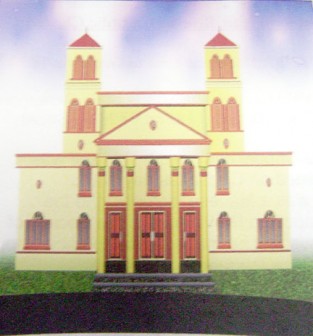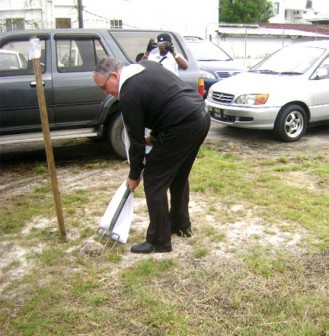Rebuilding of the Sacred Heart Roman Catholic Church on Main Street in the city is set to begin within the next few weeks following the turning-of-the sod ceremony at the burnt out site yesterday afternoon.
The project will be undertaken in three phases, the construction of the main church building, the presbytery and a parish hall, with the completion of the former set to be completed by year end. The main church building stands at an estimated cost of $85 million.
Speaking at the launch of the reconstruction process at the Lot 67 Main Street site yesterday, parishioner Ramsay Ali, who has played an integral part in the project coming off the ground, said that completion of the entire project depends on how much money can be raised. He said that the $24 million garnered thus far is enough to construct the foundation of the place of worship, inclusive of the steel frame it will now have.

Ali said persons might ask why construct a building which is so costly when you only have $24 million, but he said that while raising funds for the project—from the time of the fire to yesterday—a significant number of persons have said because of the time lapse between the fire and today, “if we start to build something and we see it going up, then we will start to contribute.”
He said he believes more persons will contribute towards the project, noting that on the day of the announcement of the rebuilding was made, a parishioner made a sizeable contribution. The sum of $10 million was raised over the years, which was spent on clearing the site and fencing the area, and Ali stated that a significant portion of the sum was obtained via the parish through its fund-raising activities.

“At first, when the project was decided, a plan of $200 million was made and persons said that was too much,” Ali said. The parish went back to the drawing board and returned to corporate Guyana, and while not afraid of hearing no, Ali said the parish remains hopeful of the support of the public. He said too that the parish plans to “tap into the Diaspora” including North America, where a vibrant Roman Catholic community stands.
The parish will continue to hold its fundraising activities such as fairs, concerts, and tea parties and the next planned event, the annual Holy Thursday cross buns sale, is set to add significantly to the rebuilding fund. Ali said that as much as $1 million is usually garnered in sales for that day.
Bishop Francis Alleyne, who said the opening prayers at yesterday’s ceremony, stated that shortly after the December 2004 fire, he met persons from the area. Most of them were not avid church goers but were active members of the Catholic community. He said what impressed him most during the meeting was “the way people hoped for the church to be rebuilt, with affection and gratitude.” He said the church, in its physical state, “said something to those persons which other buildings did not say.”
The Bishop expressed hope that the plans for the site will see a catholic resource centre, a place for library facilities, archives, and a media centre for the holding of workshops. He said the project is still at the “dream stage of discussion but as the vision takes form, the hope is there that as much as possible will be fulfilled.”
The Bishop noted that the recent grenade incident at the Stabroek Market square had many persons gripped with fear and conditioned to expect a repeat of similar events; this being an elections year. But he noted that “our faith informs us otherwise.” He said faith is expressed in a language of harmony.
He said he was in conversation about some concerns with pastoral issues in Georgetown and around Guyana and noted that there is “clear information” of a high incidence of distress, despair, anger and violence in the home. He said that it is something growing among our people. Sr Mary Noel Menezes, recounting briefly the history of Sacred Heart, told the gathering that it could be difficult to describe the 143-year-old church. She said it was established at an important time in 1861, when a chapel designed by Father Schembri was opened. The church derived from a mainly Portuguese population brought as indentured immigrants to these shores.
At the time, it was built at a cost of $18,000 on land which cost the church at the time only $1,000. Menezes said that original structure was expanded overtime and became the centre of Portuguese population with the 3 am Christmas novena back then taking centre stage.
In 1962, the church was declared a national shrine of the Sacred Heart and the primary school was established around this time.
Meantime, persons who wish to contribute towards the rebuilding project can obtain more information by visiting the website www.sacretheart.gy, by email at info@sacretheart.gy or on telephone number 226-4631.
Donations can also be made directly to bank accounts at: Republic Bank – account number 268-496-7, Scotiabank – account number 10006626, Guyana Bank for Trading and Industry (GBTI)- account number 3802530 or the New Building Society (NBS) – account number 134769.





